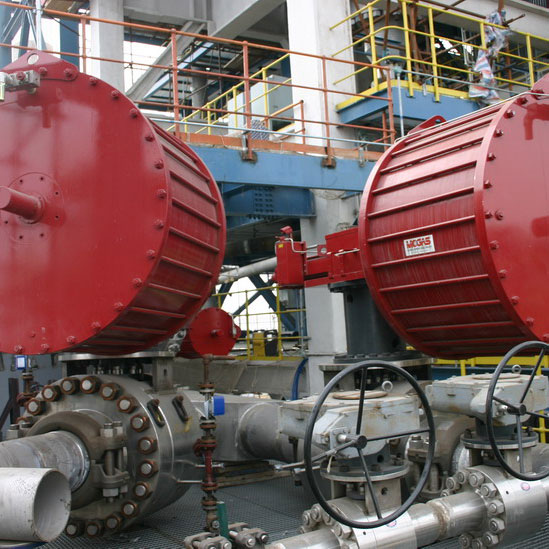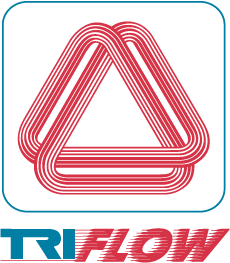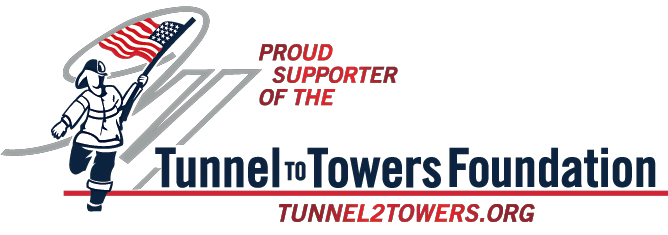
An automated Class 2500 14-inch severe service metal-seated ball valve in service isolating high pressure and hot hydrogen catalyst.
Trusted Partner at Refineries, Central Engineering and Licensors in Oil & Gas
Working with refineries, new valve technologies and licensors in oil and gasification applications—especially in heavy oils and cokers—to resolve the most challenging issues has been a TRIFLOW CORP strength for decades.
Some of our Refining and Oil & Gas experience includes…
Heavy oils, severe service, double-block-and-bleed automated isolation ball valves, ASME B16.34 Class 2500 and under, and Table A-1 Bore, with metal-to-metal API 598 sealing, extended high temperature packing to minimize fugitive emissions. Ball and seats with a high thermal-resistant hard coating. Pressures up to 2200 psig and temperatures to 950° F.
Fluid catalytic cracking (FCC) metal-seated, hydraulically operated large triple offset control and isolation valves up to 84 inch suitable for extreme temperatures designed to extract energy from a high-pressure stream of flue gas, converting the gas’s kinetic and potential energy into rotational mechanical energy (megawatts)
Metal-to-metal floating ball valves with hard-coated high temperature seats and ball for regenerator dump up to 1200°F. Ball valves to remove spent catalyst from the regenerator; double block and bleed and pneumatic, MOV, or manually actuated. Valves will see abrasives, thermals and possible erosion.
Combined function isolation/control/check valves up to 84 inch for fluid catalytic cracking (FCC) to isolate, regulate velocity of gas flow, or prevent damaging reverse flow particulates/catalysts. Valve to supply air to the reactor for combustion to maintain required temperatures; remove gases from reactor; and maintain pressure levels within FCCU.
Licensors prefer manual and automated metal-to-metal seated ball valves. The process is continuous. Performance demands on the valves require special hard spray coatings and possibly material selection on ball and both seats. Hydrogen is a valuable byproduct utilized in other systems in the refiner. Valve isolation internally and externally is critical.
Licensors primarily use metal-to-metal ball valves in floating and trunnion design, and trunnion rising wedge plug in overhead vapor lines with mandatory steam purge because coking build up is high.
Large diameter isolation motor-operated (MOV) knife gate valves (KGVs) that provide a tight seal and handle large volumes of fluids or gases used in industrial applications for gas scrubbing. KGVs, based on media, can be fully bonneted.
A Sulfur Recovery Unit (SRU) needs tailgas steam jacketed isolation valves up to 42 inch that are jacketed with a constant steam heat source to maintain a temperature preventing the buildup of solidified sulfur used in sulfur recovery units and other processes that handle corrosive gases. Generally these valves are high pressure ball valves with special seating or triple offset (TOV). Both designs are jacketed and automated with MOVs.
Corrosion resistant isolation valves used in the alkylation processes approved by Licensor UOP, that use hydrofluoric acid (HF) as a catalyst. Primary HF acid valves are gates and lined plug valves.
Automated control valves that withstand high temperatures and thermal cycling to regulate the flow of hot oil in process equipment based on the required temperature and pressure specifications ensuring optimal quenching conditions in fluid catalytic cracking or hydrocracking applications
Isolation valves, manual or automated, with larger sizes that can be fabricated bonneted knife gate valves (KGV) or metal-to-metal seated blowoff valves (BFVs) or triple offset valves (TOVs) to control the flow of flare gas to the flare stack to prevent the uncontrolled release of flare gas into the atmosphere often integrated with safety systems, including pressure relief valves and emergency shutdown (ESD) systems
Ball, knife gate (KGV), butterfly (BFV), gate, globe, and check valves for pump suction isolation and flow control of water from an intake source to a pump. Materials can vary due to water make up.
Automated and manual isolation valves such as ball, gate, butterfly, triple offset (TOV), and emergency shutoff (ESD) control valves with automated control systems to manage the flow of gasoline and other fuel products within refinery systems



